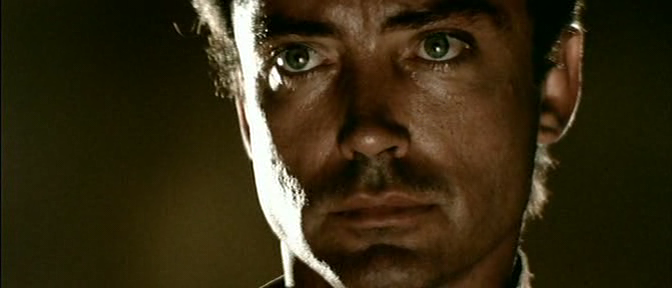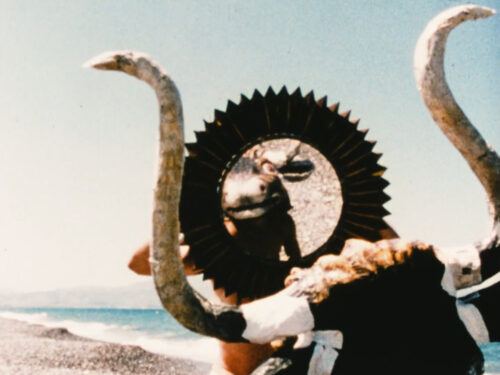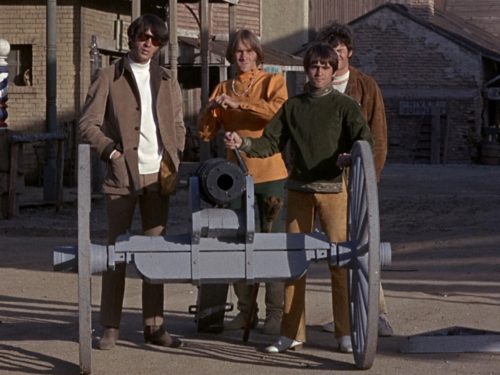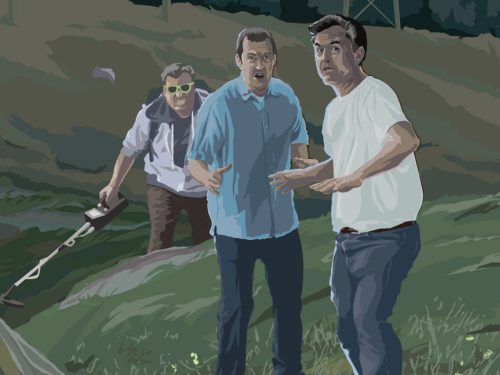When a group of R.W. Fassbinder’s frequent collaborators met on an island in the Philippines to make an exploitation film, the production and the resulting movie were anything but what was expected
Merely mentioning the name Rainer Werner Fassbinder will prompt all sorts of associations for film fans. Depending on who you ask, one might think of the New German Cinema, a groundbreaking period beginning in the early 1960s in which a new generation of filmmakers emerged in response to the artistic and political stagnation of West Germany, Fassbinder among them. Alternatively, one might think of excess and provocation, as Fassbinder constantly found himself in the headlines — if not for his films, then for his incendiary views and outrageous behavior. Someone particularly fond of the filmmaker’s work might think of the Antitheater, the collective of actors and technicians who first brought Fassbinder’s plays to life and later helped realize his cinematic vision, both in front of and behind the camera.
Less likely to come to mind is exploitation filmmaking, although several of Fassbinder’s regular collaborators would find a home in this sphere to varying degrees of success. Udo Kier remains the most notable, having appeared in canonized classics like Mark of the Devil (1970), House on Straw Hill (1976), Blood For Dracula (1974), and numerous others. Ulli Lommel, one of Fassbinder’s go-to leading men, directed several memorable, low-budget horror and exploitation films in America, including the surprise box office success The Boogey Man (1980).
One Fassbinder-adjacent project, however, stands apart as particularly notable, if only for its peculiar and turbulent journey to the screen: the 1983 Women in Prison feature, Die Insel der blutigen Plantage (The Island of the Bloody Plantation), written and directed by longtime Fassbinder collaborator, Kurt Raab. Within the crowded subgenre of Women in Prison movies, it’s fairly unremarkable, but its legacy — sadly, largely forgotten — as a product of friendship and creative camaraderie, as well as its stranger-than-fiction production, renders it a fascinating (if flawed) film worth further consideration.
By the time he set to work on the film’s screenplay, Raab was no stranger to controversy. In 1973, he wrote and starred in Die Zärtlichkeit der Wölfe (The Tenderness of Wolves), a melancholy study of serial killer Fritz Harmann, the “Butcher of Hanover,” who assaulted and murdered over 20 young men and boys between 1918 and 1924. The film’s frank depiction of homosexuality roused more outrage than its violent, pedophilic subject matter, and Raab, himself openly gay and interested in the ways this tragic story highlighted the corrosive effects of repression, isolation, and social indifference, drew the ire of social conservatives and various gay rights groups. His history with provocation dates back even further with his long-term association with Fassbinder.
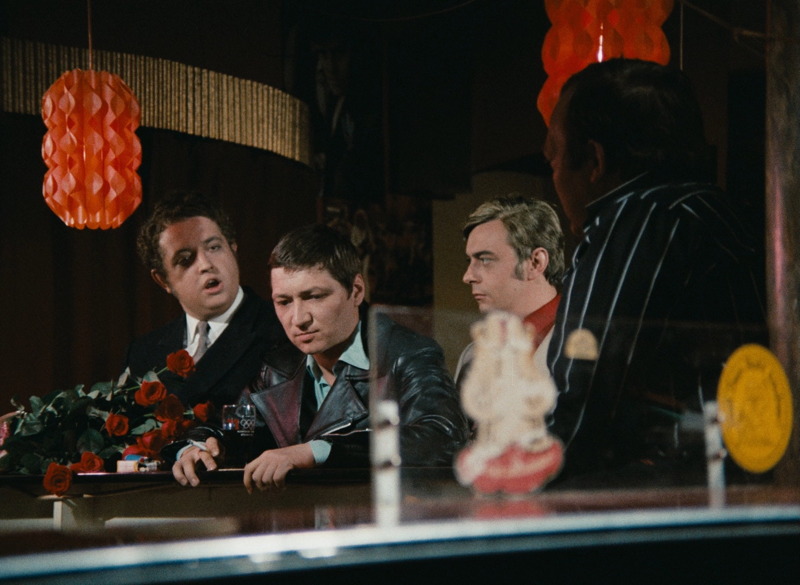
From 1967 to 1977, Raab worked as a member of Fassbinder’s stock company, first as an actor, and later in an assortment of roles from assistant director and costumer, to arguably his true métier, production design. With Fassbinder, Raab made films that challenged and interrogated the West German status quo and the injustices and inequalities (both social and institutional) it served. Though their creative union was fruitful, their complicated and turbulent personal relationship eventually imploded after a protracted falling out. Raab found himself severed from the man and work that so crucially shaped his identity. After this ex-communication, the complicated social dynamics of Fassbinder’s inner circle initially made it difficult for Raab to keep in close contact with the friends who remained within; but some in the Fassbinder stable were less shackled to the director than others. One such person was Austrian actor Peter Kern.
While Kern worked primarily as an actor throughout the 1970s, appearing in numerous films by several New German Cinema luminaries, he would eventually assert himself as an iconoclastic force in West German cinema as a director, making over 20 feature films. Kern cultivated a reputation of provocateur through his creative focus on transgressive subject matter, his combative and adversarial dynamic with critics and audiences, and his outspoken anti-establishment views and support of gay rights (Kern was openly gay and frequently explored homosexuality in his films). It’s no wonder, then, that he found kinship with Kurt Raab.
Feeling frustrated with their respective careers and united by a shared desire to focus only on personal projects that aligned with their creative ambitions, Raab and Kern formed a production company, Luxor-Film. Kern would produce, Raab would write, and they’d enlist their friends — many from Fassbinder’s stable — to contribute in various capacities. The first Luxor-Film venture was the surreal 1981 comedy Heute spielen wir den Boß (Today We Play the Boss), directed by frequent Fassbinder collaborator Peer Raben and featuring a slew of Fassbinder regulars as cast and crew. The film premiered at the San Sebastian Film Festival in September 1981 and later aired on West German television, but failed to muster much enthusiasm from the general public.
While developing additional projects for Luxor-Film, Raab and Kern quickly concluded that a “one for us, one for them” approach would best enable them to produce the kind of work they truly believed in. In an interview included on the Mediawith Classics DVD release of The Island of the Bloody Plantation, Kern explains:
“It was really hard for [Raab and me] to be able to shoot films corresponding to our heart and our intellect. The subjects were too complicated and it was more difficult to afford [to produce] these films. We wanted to make a film which would shovel us free and then give us the opportunity to shoot films which we really wanted to make. And so we speculated on a subject that would affect a wide audience…. that we could sell on a large scale to earn a lot of money, so that we could produce the films we wanted.”
Kern and Raab turned to exploitation filmmaking, a tried and true method for low-budget filmmakers to turn a quick profit. For both of them, the lurid subject matter and sensationalistic sex and violence common to the genre seemed guaranteed to draw an audience. Add in a simple story of good vs. evil (in this case, vile Nazis getting theirs) and how could they go wrong?
Picture this idyllic scene: two young, beautiful women, out for a day of adventure on the sea, bring their boat ashore a remote island somewhere in the South Pacific. They’ve found their ideal sunbathing spot. Their fun in the sun is quickly cut short, however, when they are both shot by a rifleman hiding in the nearby bushes.
This jarring moment of violence opens Island of the Bloody Plantation (or, Escape From Blood Plantation), setting the tone for what follows.
The basic premise is simple: a group of fascists implied, but never outright stated to be Nazis, flee their falling regime and occupy the remote island, establishing a private security force and enslaving the indigenous population. The island’s young women are forced into slave labor and endure brutal physical conditions and sexual humiliations at the whims of their captors, while the men are enlisted for extra help with labor and patrols. The operation is overseen by an egotistical despot, Otto Globocnik (Karl-Otto Alberty), and his wife, Olga (Barbara Valentin), whose sadistic escapades in her fading glory days earned her the moniker “Bloody Olga.” When prison guard Herman (Udo Kier) embarks on a clandestine relationship with Cora (Karen Lopez), an island captive, they instigate a prisoner rebellion.
It’s a setup any seasoned fan of exploitation cinema will recognize as fairly boilerplate. Bloody Plantation fits neatly into the template of “jungle prison” films that emerged as an offshoot of the popular Women in Prison subgenre, with some Nazisploitation elements thrown in for good measure. One imagines that Raab, whose opinions on the West German public’s incomplete reckoning with its Nazi past very much aligned with Fassbinder’s, must have relished the opportunity to relitigate this history, albeit in sleazoid fashion.
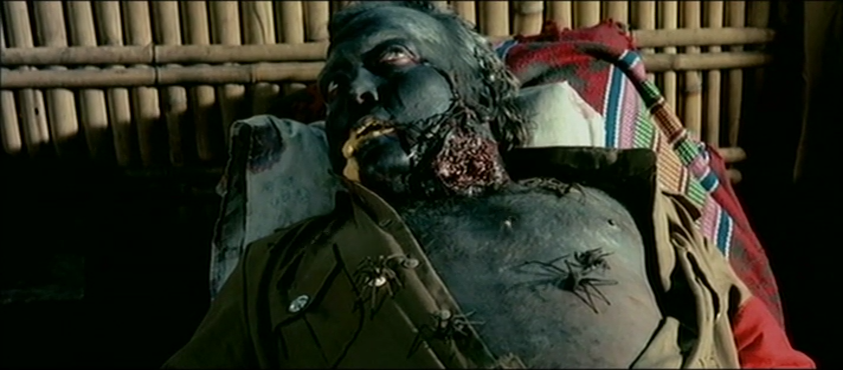
As the film progresses, however, it begins to complicate this basic formula in a few key ways. The most obvious example of this subversion of expectations is the relative lack of gore and sexual depravity that characterizes the genre. While The Island of the Bloody Plantation provides the requisite violence, T&A, and squirm-inducing moments (including one memorably gnarly death by spider bite), it’s not exactly Gestapo’s Last Orgy (1977). Raab exercises restraint throughout when the subject matter practically begs for excess, and repeatedly backs off in moments other directors would milk for maximum sleaze. It’s a puzzling choice, given Raab’s and Kern’s conviction to profit from the puerile. Even when they’re trying not to, they can’t help but indulge their arthouse impulses, and that extends to everything from the film’s gorgeous island setting, beautifully lensed by cinematographer Rudolf Blahacek (Sukkubus, Miko: From the Gutter to the Stars), to the production design (by Raab, of course) and editing by Karl Aulitzky (no stranger to sleaze himself as editor of Jess Franco’s Bloody Moon and Linda). The most baffling creative decision is the inclusion of the comically exuberant theme song performed by Shane Colin. The theme plays over the opening credits and creates a tonal vacuum that completely sucks the air out of the tension established in the opening scene.
Apart from these atypical creative decisions, the film also diverts from the standard formula it initially appears to establish with the addition of two melodramatic story elements, to arguably mixed results. The first and less successful of the two involves Eva (Karina Fallenstein), a young woman smuggled onto the island with the help of Miguel (Fouad Mediouni-Zaoudi, Raab’s longtime partner), a crewman on a supply boat captained by Röder (Peter Kern) that regularly stops at the island. Eva comes to the island with the hope of reuniting with her long-lost mother, Olga, intending to persuade her to leave to start a new life together. It’s a subplot that could have bolstered the emotional stakes of the film, but it does the exact opposite: Eva never seems to be in much of a hurry to make contact with Olga, and their interaction is limited to a very brief exchange during the film’s climax that immediately precedes one of their deaths. In the end, Eva’s role amounts to little more than a convenient way to get the supply boat back to facilitate an escape.
The second, more radical addition involves Raab himself playing prison guard Bevney, a gay, religious zealot who proselytizes to his harem of young island men. It’s not uncommon for queer filmmakers working within the typically heteronormative confines of exploitation cinema to inject coded symbolism or a certain camp sensibility into their work; take, for instance, Reform School Girls (Tom DeSimone) and Bad Girls Dormitory (Tim Kincaid, aka all-male cinema icon Joe Gage), two obvious examples within the Women in Prison subgenre. Raab does this, too, in little touches throughout, such as when his character cattilty refers to Kier’s as “Miss Hartmann,” or through the bizarre pomp of the regime’s corporal punishment ceremonies. Raab stages them outside Gobocnik’s palace in an area designated the “Square of Justice.” Globocnik and Olga preside over the public whippings while donning Rococo attire as their dwarf servants yuck it up.
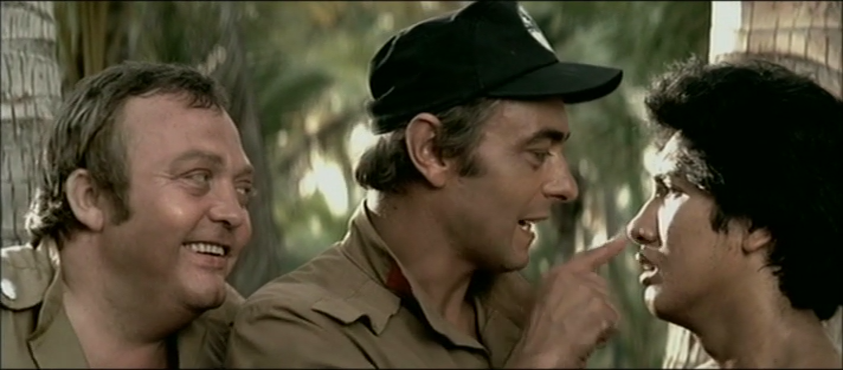
It’s also Bevney’s character arc, informed in equal parts by Raab’s life-long Catholicism, interest in history, and his commitment to putting unambiguous depictions of homosexuality on screen, that provides the film’s most peculiarly compelling side plot. When Bevney’s beloved young men are killed as part of the island women’s righteous vengeance, he subsequently loses his mind. He becomes convinced he is the Roman emperor Tiberius, eventually drowning himself to be with his beloved “children.” While girl-on-girl action is a Women in Prison staple, depictions of male homosexuality are less common, especially ones as singularly bizarre as what Raab delivers here. It’s easily the most interesting aspect of the movie, which, when removed from the context of its proximity to Fassbinderland, would be easy to dismiss as a fairly forgettable entry in the bloated annals of exploitation cinema were it not for the eyebrow-raising calamity that plagued its production.
When it came time to start thinking about where to shoot the film, Kern recalled a conversation he had with Celso Ad. Castillo, a Filipino filmmaker he met at a film festival, who invited him to make a movie in the Philippines.
As one of Asia’s oldest film producers, the Republic of the Philippines boasts a robust and wildly productive film industry. During its first Golden Age in the 1950s, the four major studios in the Philippines — LVN Pictures, Sampaguita Pictures, Premiere Productions, and Lebran International — averaged about 350 films per year. Like any other creative ecosystem, it weathered some turbulent ups and downs, including strict censorship under the martial law of the Marcos regime. Nevertheless, throughout the ’60s and ’70s, the industry flourished with a booming local film culture and a parallel trade in exporting cheap features for the international market. An alternative, independent film scene established itself in Manila, coinciding with the arrival of numerous American filmmakers and co-productions, as well as what German media theorist and journalist Tilman Baumgärtel calls “the Sine-Kino connection.” This was a period of intense collaboration and cultural exchange between German and Filipino filmmakers that began in the mid-to-late ’70s, when filmmakers, critics, and other industry professionals from Germany made their way to the Philippines to work, lecture, and exhibit their films, some by invitation from the Goethe-Institut Manila, others on their own initiative.
The filmmaking workshops held by the Goethe-Institut (which counted future Filipino filmmaking icons Lav Diaz, Mark Meily, and Nick Deocampo among their attendees) were crucial in fostering the alternative film scene in the country; they not only offered the opportunity to see numerous West German films, including many avant-garde works, but also made filmmaking equipment accessible to young filmmakers. For visiting German filmmakers, these unique circumstances provided them the opportunity to reach a new audience and soak up the local culture.
The Philippines also carried added appeal in the form of cheap production costs. On international co-productions, many local producers would cover below-the-line expenses, so what would require thousands of dollars to finance in Germany came comparatively cheap in the Philippines. The prospect of inexpensive labor and an ideal setting for on-location shooting led Peter Kern to ring Castillo to take up his offer to get production rolling in the Philippines. Castillo knew how to make action movies on a low budget, which was exactly the kind of expertise Kern needed. More importantly, his offer came with the promise of financing. Castillo brought in friend and colleague Felipe G. Ortega, Jr., who he assured would be able to cover half of the production costs. Kern and Raab would rope in a few friends — Udo Kier, Barbara Valentin, Hans Zander — and a couple of bigger name German actors, while Philippine locals would fill out the rest of the cast and majority of the crew. At last, everything seemed to be coming together. Confident in the viability of the production, Kern invested 250 thousand marks into pre-production preparation, assembled his team, and made the necessary arrangements for their arrival in the Philippines.
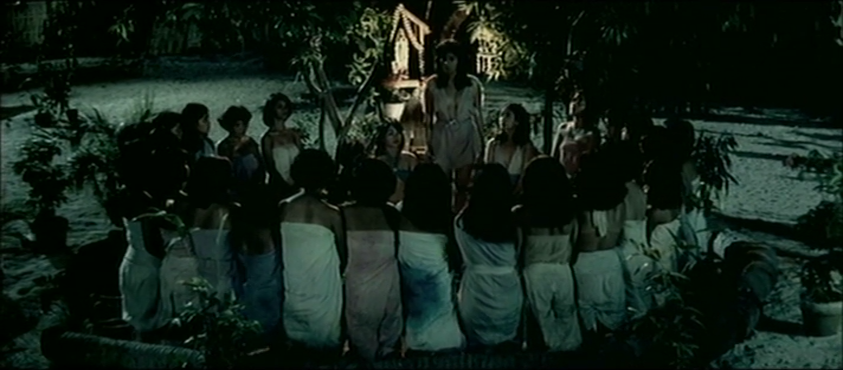
Once Kern and the rest of the West German crew arrived in Manila, however, the situation deteriorated with alarming rapidity. Kern barely settled into his hotel room when Ortega showed up to inform him that the money he promised didn’t exist. He was flat broke. Kern recalls:
“In such situations, I’m always very calm. I smiled at him… then I went to the toilet and cried. I cried my eyes out. I looked at myself in the mirror and said: There you are. Deeply in the shit, just because you want to realize such speculative rubbish. But you have to go through with this. You’ve set yourself a goal.”
Shaken but undeterred, Kern resolved to finance the movie entirely on his own, even as the obstacles continued to mount. When Castillo learned Kern would no longer be cooperating with Ortega, he attempted to pull out of the production. This would have been disastrous, as most of the Filipino cast and crew had been brought in by Castillo; in fact, many were his family and friends. Were he to go, so too would most of the crew. Kern managed to bribe Castillo into staying on, and with this debacle seemingly resolved, they headed 127 miles north to the beautiful beaches of Iba, Zambales, to start filming.
After three days on location, they only managed to shoot one scene. Castillo, it turned out, needed time to gather inspiration, and inspiration could only be found through the consumption of copious amounts of alcohol. Kern knew an untenable situation when he saw it and made the decision: Castillo had to go, even if it meant losing the majority of the crew. Kern acknowledges this moment of clarity in the Mediawith interview, as he fondly recalls how Raab, in their moment of crisis, helped him keep it together:
“Once, when we were shooting together in the Pyrenees, we had a break in Lourdes. Kurt is such a religious, mad one. He said: ‘Come with me, I’ll show you something!’ He showed me the Madonna in Lourdes. We both touched this stone and we swore to ourselves: no matter what will happen in this world, what will try to separate us…. we’ll stick together. And now [in the Philippines], Kurt Raab held me to my promise. He said, ‘Peter! Solidarity!’ This was the slogan. I said, ‘OK, Kurt, solidarity. You’ll direct and I’ll produce the film.’ And we made the film. It had to be finished in ten days.”
Although Kern quickly managed to recruit a German replacement crew, Castillo’s departure nevertheless delivered a devastating blow to the financial viability of the production. Further, the sudden shakeup in personnel shifted the responsibility of directing onto a reluctant Kurt Raab, who was already pulling triple duty as writer, unit manager, and production designer.
In his memoirs, Raab paints a hellish picture of the morale-obliterating experience:
“The Filipino director is constantly drunk and he can’t think of anything to do with our screenplay. We fire him and I have to take over the direction now, too. I become a tyrant and a fanatic, ignoring fatigue. I work 16 hour days because I’m overcome with fury and my only ambition is to finish the film, whatever the cost. I rage, scold and bluster, I’m obnoxious and disgusting, I yell at people moodily, justified or not, and by the end I’m so exhausted that I’m falling over and needing glucose infusions to keep me going.”
Despite the grueling workload, immense pressure and breakneck pace, Raab managed to get a good amount of footage in the can. Meanwhile, unbeknownst to him and the rest of the crew, Ortega initiated legal proceedings to halt the production. If he and Castillo couldn’t be involved in making the movie, neither could anyone else. A judge ordered Kern to surrender his camera and equipment, not realizing that all of it was rented. Kern resolved to hide the equipment and film materials inside a local church, but the temporary solution didn’t last; he had to relinquish everything — including footage in the can — to Ortega. It seemed they reached the end of the road.
Except Kern refused to give in. Instead, he devised a plan:
When Ortega arrived on set to collect the materials, Barbara Valentin would convince him to move everything indoors to her air-conditioned hotel room, where it would be safe from the blazing sun. This hotel room, quite fortuitously, had two ways in and out — but only one obvious entry and exit point. Once they arrived in the room, Valentin would charm Ortega over drinks to distract him, while Udo Kier quietly slipped into the room through the other door to grab the negatives and get the hell out of Dodge. To their astonishment, the plan went off without a hitch and Ortega walked away with the decoy: a box full of rocks.
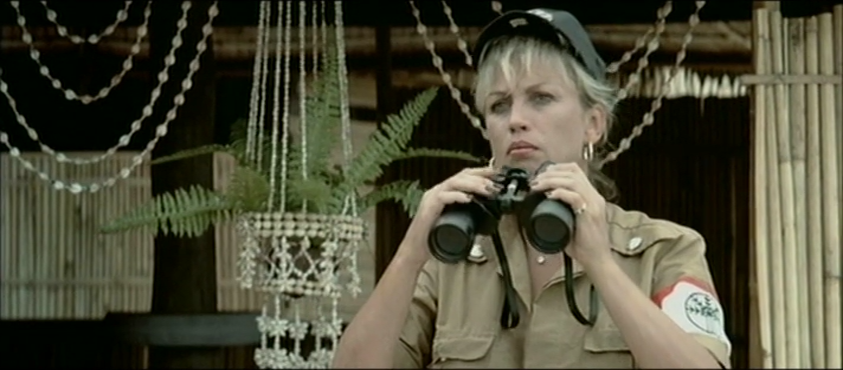
Against improbable odds, production on The Island of the Bloody Plantation wrapped, at last, in May of 1982. It eventually premiered at a West Berlin film festival in January of 1983. The film achieved modest success in South Asian markets, but faced censorship in West Germany. After a brief theatrical run, its VHS release ran afoul of the Bundesprüfstelle für jugendgefährdende Medien (BPjM), or the Federal Department for Media Harmful to Young Persons, and landed on the organization’s list of indexed films.
This turn of events did not lead to the financial and commercial success Kern and Raab sought, and ultimately, the financial blow of their ill-fated excursion to the Philippines proved too disastrous to overcome. Though Raab subsequently wrote numerous scripts for Kern, most would remain unproduced. The final Luxor-Film production, a critical documentary on the Marcos regime directed by Werner Schroeter for West German television, aired in the Fall of 1983. Raab and Kern remained friends and appeared together in several film and television productions throughout the remainder of the decade, but they never attempted another long-term collaboration.
Raab continued to find steady work in film, television, and the theater, including roles in films by Barbet Schroeder (Tricheurs) and Agnieszka Holland (Angry Harvest), a stint as co-writer, casting director, and second unit manager on the popular West German television series Kir Royal. He also played supporting roles in major international co-productions such as Mussolini and I (1985) and Escape From Sobibor (1987). Raab seemed poised to transition to bigger, better things; maybe even Hollywood, where his friends and colleagues Udo Kier, Michael Ballhaus, and Ulli Lommel found a home. Tragically, fate had other plans. In 1986, Raab learned he was HIV positive. In 1987, he became the first public figure in Germany to publicly disclose his HIV status and spent the rest of his life tirelessly working to destigmatize HIV/AIDS through numerous press interviews and television appearances. His powerful video diary/documentary, Yearning For Sodom, posthumously earned him the Adolf Grimme Award and the Grand Prix Cinéma du Réel. He passed away from AIDS-related complications on June 28, 1988, at the age of 46.
Peter Kern made his own directorial debut in 1987 with the raunchy comedy Crazy Boys — Eine Handvoll Vergnügen (A Handful of Fun) and spent the next several decades courting controversy with his filmmaking, including several collaborations with fellow Austrian film icon, Helmet Berger. Following Bloody Plantation, he also continued to act and appeared in films by Werner Schroeter, Peter Zadek and Ulrike Ottinger, among others, and collaborated often with multi-disciplinary provocateur Christoph Schlingensief. Kern passed away at the age of 66 in August of 2015.
Fassbinder’s own untimely death arrived on July 10, 1982, the result of a lethal combination of cocaine and barbiturates. He was 37 years old. The news sent shockwaves across West Germany, heralding what many recognize as the official end of the New German Cinema. His death blindsided many of his collaborators — especially Raab, who felt tortured over business between them that would forever remain unfinished. Yet despite all of the agony, Fassbinder’s memory brought light to the darkness on the set of Bloody Plantation; a steady reminder to persevere when the cast and crew would gather to reminisce at the end of those very long days. Solidarity to the end.
Stay up to date with all things Split Tooth Media and follow Adrianna on Twitter
(Split Tooth may earn a commission from purchases made through affiliate links on our site.)

